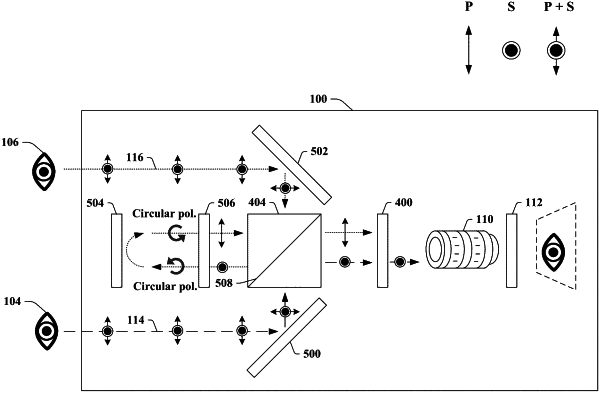| CPC G06V 10/147 (2022.01) [G02B 5/3083 (2013.01); G02B 27/0093 (2013.01); G02B 27/283 (2013.01); G06V 40/19 (2022.01); H04N 23/80 (2023.01)] | 20 Claims |

|
1. An iris scanning device, comprising:
front end optics configured to receive a first optical signal from a first eye and a second optical signal from a second eye of a person;
a polarization beam splitter;
a polarization selector;
a lens optically coupled to the polarization selector; and
a camera sensor optically coupled to the lens;
wherein the polarization beam splitter optically propagates a first portion of the first optical signal having a first polarization to the polarization selector and a second portion of the second optical signal having a second polarization to the polarization selector, wherein the polarization beam splitter inhibits optical propagation of a second portion of the first optical signal having the second polarization to the polarization selector and a first portion of the second optical signal having the first polarization to the polarization selector, and wherein the first polarization and the second polarization are orthogonal to each other;
wherein the polarization selector is configured to receive the first portion of the first optical signal and the second portion of the second optical signal;
wherein the first optical signal is representative of the first eye of the person and the second optical signal is representative of the second eye of the person;
wherein the polarization selector selectively allows a passed optical signal to be optically propagated to the lens during a time period and inhibits a blocked optical signal from being optically propagated to the lens during the time period, the passed optical signal being one of the first portion of the first optical signal or the second portion of the second optical signal during the time period, and the blocked optical signal being a differing one of the first portion of the first optical signal or the second portion of the second optical signal during the time period;
wherein the polarization selector allows one of the first polarization or the second polarization to pass to the lens and inhibits a differing one of the first polarization or the second polarization from passing to the lens; and
wherein the lens causes the passed optical signal to be incident on the camera sensor during the time period.
|